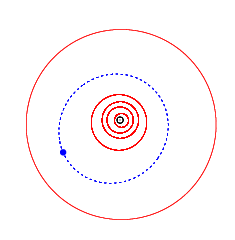Discovered by E. W. ElstV. Ivanova Minor planet category main-belt · (outer) Discovered 8 August 1986 Orbits Sun | Discovery date 8 August 1986 Alternative names 1986 PN4 · 1981 UV12 Observation arc 34.60 yr (12,636 days) Aphelion 3.66 m Asteroid group Asteroid belt | |
 | ||
Discoverers Violeta G. Ivanova, Eric Walter Elst | ||
9936 Al-Biruni, provisional designation 1986 PN4, is a carbonaceous asteroid from the outer region of the asteroid belt, approximately 24 kilometers in diameter. It was discovered on 8 August 1986, by Belgian and Bulgarian astronomers Eric Elst and Violeta Ivanova at the Rozhen Observatory, located in Bulgaria's Smolyan province near the border to Greece.
The C-type asteroid orbits the Sun at a distance of 2.5–3.7 AU once every 5 years and 5 months (1,978 days). Its orbit has an eccentricity of 0.19 and an inclination of 15° with respect to the ecliptic. The first precovery was taken at Crimea-Nauchnij in 1981, extending the asteroid's observation arc by 5 years prior to its discovery.
A rotational light-curve was obtained for this asteroid from photometric observations made at the U.S. Goodsell Observatory (741), Minnesota, in August 2002. The light-curve gave a rotation period of 7001107040000000000♠10.704±0.010 hours with a brightness amplitude of 0.14 in magnitude (U=2)
According to the space-based surveys carried out by the Japanese Akari satellite and the NEOWISE mission of NASA's Wide-field Infrared Survey Explorer, the asteroid measures between 23.9 and 27.8 kilometers in diameter, and its surface has a corresponding albedo of 0.048 to 0.065. The Collaborative Asteroid Lightcurve Link assumes a standard albedo for carbonaceous asteroids of 0.057 and calculates a diameter of 22.2 kilometers, based on an absolute magnitude of 12.0.
The minor planet was named after the Persian scholar and polymath Al-Biruni (973–1048). Regarded as the founder of Indology and the father of geodesy, he made important contributions to anthropology, mathematics and astronomy. In particular, he is known for developing a method for the summation of series, for solving algebraic equations, and for the triangulation of distances on Earth's surface. Naming citation was published on 26 September 2007 (M.P.C. 60728). The lunar crater Al-Biruni is also named in his honour.
